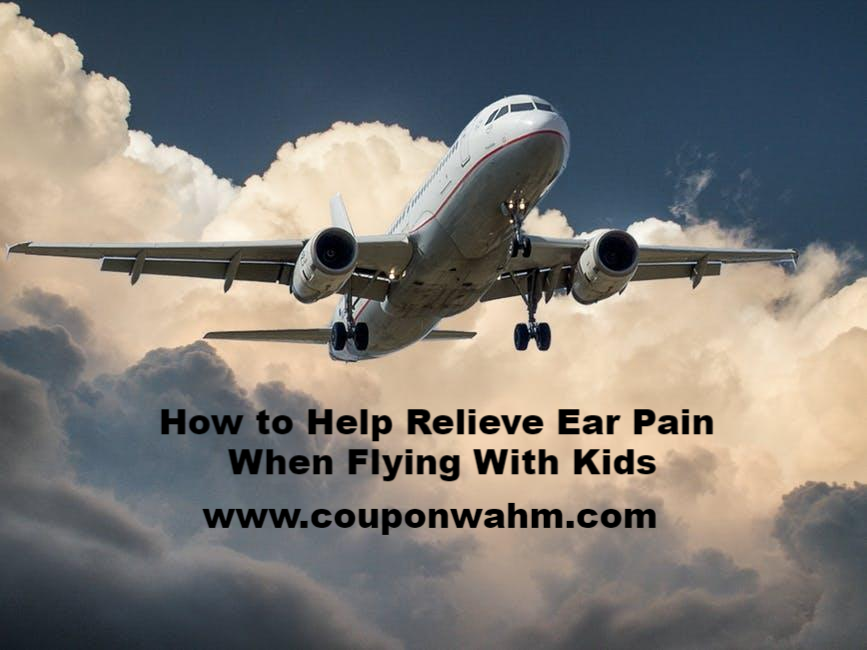How to Help Relieve Ear Pain When Flying With Kids

Have you ever noticed that kids tend to have more pain in their ears when flying? There’s a physiological reason why that happens.
Children and infants have relatively narrow Eustachian tubes. As a result, it is harder for infants and young children to regulate air pressure, which leads to pain and discomfort.
Airplane flight is particularly problematic because there is less air pressure the higher up a plane is flying. Additionally, airplanes tend to have less moisture, which promotes mucus build-up and clogs nasal passages.
While kids are naturally at a disadvantage, you can still use a few techniques to help make a flight go a little smoother. We’ll cover some of these helpful tips below.
How Old is Your Child?
You’ll first need to consider how old your child is. Infants and toddlers tend to have a tougher issue with ear pain with flying because they aren’t old enough to know about or perform self-care tips that can keep them comfortable.
If this is the case, you must be extra careful about flying because their ear pain is entirely in your hands. As annoying as a baby crying on a plane may be for other people onboard, just imagine how much discomfort your child must be in!
Anytime an infant or toddler is in pain, they often have no idea what is causing it. This is always extremely alarming for them and should be avoided at all costs.
Slightly older children (above the age of three) are a little easier to work with because they can physically perform procedures like gently forcing air through their ears by plugging their nose and mouth and exhaling.
Regardless of age, sometimes you don’t have much choice about taking a flight with your younger children. You’ll need to be particularly vigilant about ensuring their comfort due to their natural weakness with narrower Eustachian tubes.
Be Awake for Landing and Takeoff
One thing you should always do is make sure your kids are fully awake during takeoff and landing.
This is because these are the two most prominent times for ear pain during flight.
While it is true that mid-flight is when air pressure is lowest, the most dramatic changes in elevation happen during landing and takeoff. During takeoff, the plane rapidly gains altitude, while landing results in quickly descending.
Having your young children awake during this time may seem counterintuitive because it might seem more beneficial to have them asleep to avoid ear pain altogether.
This is not the case because your kids will actually swallow more, which will naturally reduce how much pain there is. A sleeping toddler or infant is one of the easiest ways to produce a crying baby because they will likely be rudely awoken by sharp ear pain!
Keep your young ones awake during both landing and takeoff, but sleeping during the flight is fine.
Stay Hydrated and Eat Snacks
Another important tip is to keep your kids well-hydrated and have plenty of snacks.
The action of drinking fluids (preferably water) and chewing on snacks will both help encourage swallowing. In turn, this will help to regulate ear air pressure.
Drinking water is also particularly important because it can help reduce mucus buildup. With a stuffy nose from a dry airplane, it becomes much harder to keep ears unplugged.
Snacks have another added benefit of requiring chewing. Anytime your child is chewing food, this movement will naturally move their ears, which can help keep adequate air pressure and therefore keep them comfortable.
Snacks might not be an option if you have an infant, but feeding them will still help keep their ears wiggling!
Gum, Hard Candy, or Pacifier
One final tip is to have some gum, hard candy, or a pacifier for a baby.
The reasons for these are fairly similar to the thought process behind having snacks. They will all keep your kid’s mouth moving and in turn, keep their ears wiggling around.
Gum is particularly beneficial because it allows for constant up-and-down movement, really helping to stimulate ear pressure. It also promotes chewing without the need to eat extra food.
Hard candy can also be fairly helpful because it requires more sucking than eating or chewing gum. Sucking on candy will naturally pull on the ears a little bit and help keep them with good air pressure.
Gum and hard candy aren’t an option if your child is still an infant. Bringing a pacifier can serve as a good supplement because it will give them something to suck on while also helping to reduce crying.
Closing Thoughts
Trying to avoid flying with an infant or toddler is the best way to prevent ear pain, but this isn’t always a convenient choice.
You cannot completely avoid ear discomfort, but you can use a few tricks to keep their ears moving around and unplugged!
Ensure your children are awake during landing and takeoff, the two quickest times to altitude shift.
Bring plenty of water and have snacks available to keep them swallowing and chewing to keep their ears moving.
Consider having gum or hard candy for children above three or a pacifier for younger kids to give them something to suck on.
Using all of these tips together will go a long way towards helping to keep your children’s ears just a little more comfortable during a flight!

very userful info. thank you very much. A simple way I used to relieve the ear pain is openning the mouse during taking off.